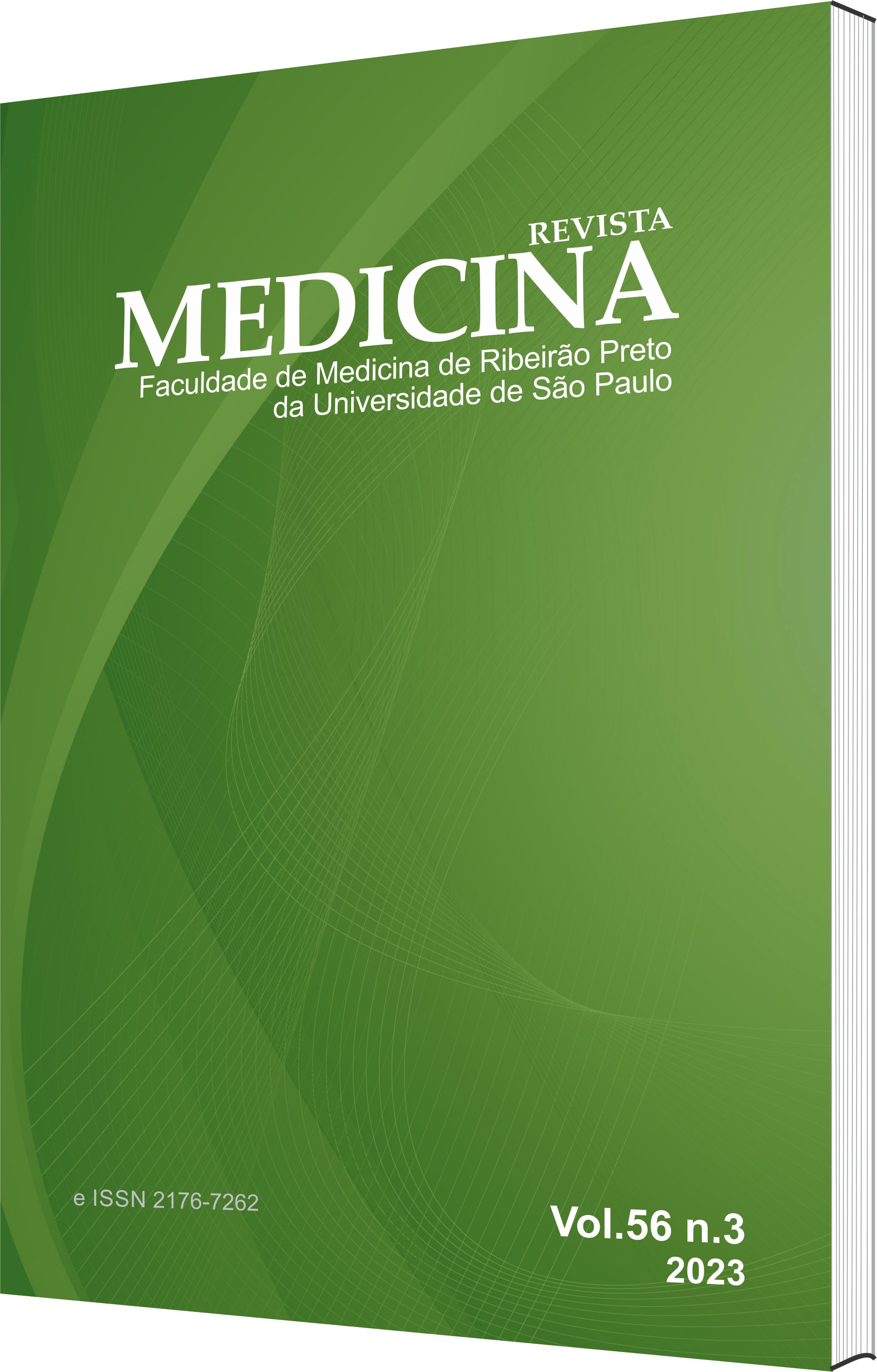Comparing follow-up of patients with vitamin K antagonists in a health center: pre- and post- COVID-19 pandemic
DOI:
https://doi.org/10.11606/issn.2176-7262.rmrp.2023.204617Keywords:
Anticoagulants, Warfarin, International normalized Ratio, COVID-19, SARS-CoV-2Abstract
Introduction and objectives: During the COVID-19 pandemic, the follow-up of patients treated with vitamin K antagonists (VKAs) may have been affected. This study aims to compare how these patients were monitored preand post-COVID-19 pandemic and understand the impact of non-face-to-face appointments on their follow-up. Methods: We conducted a retrospective cohort study in a Portuguese Health Center. The study included patients treated with VKAs and followed at the Health Center for international normalized ratio (INR) monitoring between March 2019 and March 2021. Data collected: sex, age, type of VKA; INR; date of INR assessment, type of appointment (face-to-face or phone/e-mail). Rosendaal’s method was used to calculate pre-COVID-19 and post-COVID-19 time in therapeutic range (TTR). Good TTR control was defined if values ≥ 70%. Results: 44 patients were included. The mean TTR in the pre-COVID-19 period was 64.55% (95% CI: 58.10 - 71.00%). The post-COVID-19 mean was slightly higher (+ 2.26%), 66.81% (95% CI: 59.66 - 73.97%), but the difference was not statistically significant (p = 0.576). The use of non-face-to-face appointments did not contribute to worsening post-pandemic TTR, showing no lower follow-up than during pre-pandemic period in which all contacts were face-to-face [CI (95%) -0.397 - 0.196 for a reference range -0.489 - 0.693]. Conclusions: The TTR value in both periods was similar and lower than the value defined for effective hypocoagulation. The use of non-face-to-face consultation in the post-COVID-19 period does not seem to have influenced the quality of hypocoagulation.
Downloads
References
References
Guedes M, Rego C. Estudo HIPOGAIA: monitorização da hipocoagulação oral com dicumarínicos no concelho de Gaia. 2016;35(9).
Gateman D, Trojnar ME, Agarwal G. Time in therapeutic range: Warfarin anticoagulation for atrial fibrillation in a community-based practice. Can Fam Physician. 2017;63(10):e425-e431.
Hindricks G, Potpara T, Dagres N, et al. 2020 ESC Guidelines for the diagnosis and management of atrial fibrillation developed in collaboration with the European Association for Cardio-Thoracic Surgery (EACTS). Eur Heart J. 2021;42(5):373-498. doi:10.1093/eurheartj/ehaa612
SIDDIQUI S, DEREMER C, WALLER J, GUJRAL J. Variability in the Calculation of Time in Therapeutic Range for the Quality Control Measurement of Warfarin. J Innov Card Rhythm Manag. 2018;9(12):3428-3434. doi:10.19102/icrm.2018.091203
Rosendaal FR, Cannegieter SC, Van der Meer FJM, Briet E. A method to determine the optimal intensity of oral anticoagulant therapy. Thromb Haemost. 1993;69(3):236-239. doi:10.1055/s-0038-1651587
Cope R, Fischetti B, Eladghm N, Elaskandrany M, Karam N. Outpatient management of chronic warfarin therapy at a pharmacist-run anticoagulation clinic during the COVID-19 pandemic. J Thromb Thrombolysis. Published online 2021:3-7. doi:10.1007/s11239-021-02410-w
Emren ZY, Şenöz O, Erseçgin A, Emren SV. Evaluation of Bleeding Rate and Time in Therapeutic Range in Patients Using Warfarin Before and During the COVID-19 Pandemic—Warfarin Treatment in COVID-19. Clin Appl Thromb. 2021;27. doi:10.1177/10760296211021495
Sawicka-Powierza J, Buczkowski K, Chlabicz S, Gugnowski Z, Powierza K, Ołtarzewska AM. Quality control of oral anticoagulation with Vitamin K antagonists in primary care patients in Poland: A multi-centre study. Kardiol Pol. 2018;76(4):764-769. doi:10.5603/KP.2018.0011
Kim Y, Park ES, Kang DW, Kim TJ, Lee SH. Maintenance dose of warfarin beyond time in therapeutic range for preventing vascular events. J Neurol Sci. 2019;398(November 2018):69-74. doi:10.1016/j.jns.2019.01.031
Harris DE, Thayer D, Wang T, et al. An observational study of international normalized ratio control according to NICE criteria in patients with non-valvular atrial fibrillation: The SAIL Warfarin out of Range Descriptors Study (SWORDS). Eur Hear J - Cardiovasc Pharmacother. 2021;7(1):40-49. doi:10.1093/ehjcvp/pvz071
Albabtain MA, Alharthi MM, Dagriri K, et al. Assessment of the quality of anticoagulation management with warfarin in a tertiary care center. Saudi Med J. 2020;41(11):1245-1251. doi:10.15537/smj.2020.11.25456
Asarcıklı LD, Kafes H, Şen T, et al. Time in therapeutic range values of patients using warfarin and factors that influence time in therapeutic range. Turk Kardiyol Dern Ars. 2021;49(6):463-473. doi:10.5543/tkda.2021.21015
Mearns ES, White CM, Kohn CG, et al. Quality of vitamin K antagonist control and outcomes in atrial fibrillation patients: A meta-analysis and meta-regression. Thromb J. 2014;12(1):1-20. doi:10.1186/1477-9560-12-14
Urbonas G, Valius L, Šakalytė G, Petniūnas K, Petniūnienė I. The quality of anticoagulation therapy among warfarin-treated patients with atrial fibrillation in a primary health care setting. Med. 2019;55(1):1-11. doi:10.3390/medicina55010015
Pastori D, Lip GYH, Poli D, et al. Determinants of low-quality warfarin anticoagulation in patients with mechanical prosthetic heart valves. The nationwide PLECTRUM study. Br J Haematol. 2020;190(4):588-593. doi:10.1111/bjh.16528
Björck F, Kadhim H, Själander A. Predictors for INR-control in a well-managed warfarin treatment setting. J Thromb Thrombolysis. 2019;47(2):227-232. doi:10.1007/s11239-018-1765-4
Ng DLC, Malik NMBA, Chai CS, et al. Time in therapeutic range, quality of life and treatment satisfaction of patients on long-term warfarin for non-valvular atrial fibrillation: a cross-sectional study. Health Qual Life Outcomes. 2020;18(1):1-9. doi:10.1186/s12955-020-01600-z
Price EL, Ansell J. Virtual Education for Patient Self-Testing for Warfarin Therapy Is Effective During the COVID-19 Pandemic. Jt Comm J Qual Patient Saf. 2022;48(4):214-221. doi:10.1016/j.jcjq.2022.01.001
Downloads
Published
Issue
Section
License
Copyright (c) 2023 Ana Sofia Dias Aveiro, Vítor Daniel Pereira Vaz, Soraia Antunes Pereira Ribeiro, Tiago José Reis Pereira, Ana Margarida Leitão da Silva Santos, Beatriz Nunes Graça, Marta Costa Cardoso, Carla Maria Santos Silva

This work is licensed under a Creative Commons Attribution 4.0 International License.







